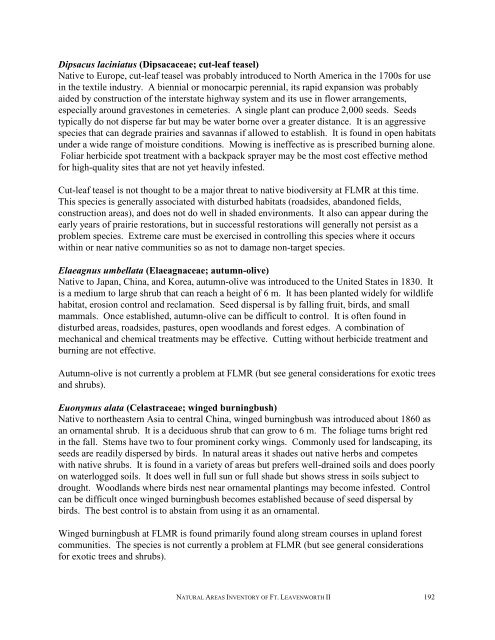A Natural Areas Inventory of the - Kansas Natural Heritage Inventory ...
A Natural Areas Inventory of the - Kansas Natural Heritage Inventory ...
A Natural Areas Inventory of the - Kansas Natural Heritage Inventory ...
Create successful ePaper yourself
Turn your PDF publications into a flip-book with our unique Google optimized e-Paper software.
Dipsacus laciniatus (Dipsacaceae; cut-leaf teasel)<br />
Native to Europe, cut-leaf teasel was probably introduced to North America in <strong>the</strong> 1700s for use<br />
in <strong>the</strong> textile industry. A biennial or monocarpic perennial, its rapid expansion was probably<br />
aided by construction <strong>of</strong> <strong>the</strong> interstate highway system and its use in flower arrangements,<br />
especially around gravestones in cemeteries. A single plant can produce 2,000 seeds. Seeds<br />
typically do not disperse far but may be water borne over a greater distance. It is an aggressive<br />
species that can degrade prairies and savannas if allowed to establish. It is found in open habitats<br />
under a wide range <strong>of</strong> moisture conditions. Mowing is ineffective as is prescribed burning alone.<br />
Foliar herbicide spot treatment with a backpack sprayer may be <strong>the</strong> most cost effective method<br />
for high-quality sites that are not yet heavily infested.<br />
Cut-leaf teasel is not thought to be a major threat to native biodiversity at FLMR at this time.<br />
This species is generally associated with disturbed habitats (roadsides, abandoned fields,<br />
construction areas), and does not do well in shaded environments. It also can appear during <strong>the</strong><br />
early years <strong>of</strong> prairie restorations, but in successful restorations will generally not persist as a<br />
problem species. Extreme care must be exercised in controlling this species where it occurs<br />
within or near native communities so as not to damage non-target species.<br />
Elaeagnus umbellata (Elaeagnaceae; autumn-olive)<br />
Native to Japan, China, and Korea, autumn-olive was introduced to <strong>the</strong> United States in 1830. It<br />
is a medium to large shrub that can reach a height <strong>of</strong> 6 m. It has been planted widely for wildlife<br />
habitat, erosion control and reclamation. Seed dispersal is by falling fruit, birds, and small<br />
mammals. Once established, autumn-olive can be difficult to control. It is <strong>of</strong>ten found in<br />
disturbed areas, roadsides, pastures, open woodlands and forest edges. A combination <strong>of</strong><br />
mechanical and chemical treatments may be effective. Cutting without herbicide treatment and<br />
burning are not effective.<br />
Autumn-olive is not currently a problem at FLMR (but see general considerations for exotic trees<br />
and shrubs).<br />
Euonymus alata (Celastraceae; winged burningbush)<br />
Native to nor<strong>the</strong>astern Asia to central China, winged burningbush was introduced about 1860 as<br />
an ornamental shrub. It is a deciduous shrub that can grow to 6 m. The foliage turns bright red<br />
in <strong>the</strong> fall. Stems have two to four prominent corky wings. Commonly used for landscaping, its<br />
seeds are readily dispersed by birds. In natural areas it shades out native herbs and competes<br />
with native shrubs. It is found in a variety <strong>of</strong> areas but prefers well-drained soils and does poorly<br />
on waterlogged soils. It does well in full sun or full shade but shows stress in soils subject to<br />
drought. Woodlands where birds nest near ornamental plantings may become infested. Control<br />
can be difficult once winged burningbush becomes established because <strong>of</strong> seed dispersal by<br />
birds. The best control is to abstain from using it as an ornamental.<br />
Winged burningbush at FLMR is found primarily found along stream courses in upland forest<br />
communities. The species is not currently a problem at FLMR (but see general considerations<br />
for exotic trees and shrubs).<br />
NATURAL AREAS INVENTORY OF FT. LEAVENWORTH II 192


